
There are three “worlds” of cycling — and perhaps surprisingly they have very little to do with each other.
Two are much appreciated by those who practice them and are quite easy to do.
While the third often appears to be close to impossible. But it is far more important than the rest combined and multiplied by a thousand.
Let’s have a look. (And pleas also check out the critical comments that follow.)
The first world of cycling is racing.
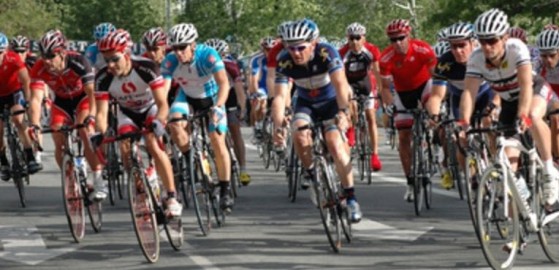
It’s great fun, the people who want to do it will do it, and other than specially designed racing facilities the rest takes place on the existing roads. As planners and policy makers we do not have to stay up at night worrying about cycle racing. Friends, it will take care of itself.
The second world of cycling is leisure cycling.
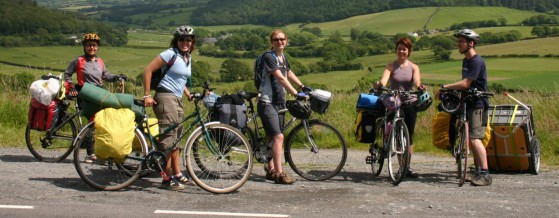
This is what takes place when the economy starts to move up and people find themselves with free time. It can be practiced alone, with children, friends and families, and increasingly in cycle touring, short and long distance. Again, expensive infrastructure is no huge barrier here, since most of it take place for the most part outside of expensive built up areas. And how do you get there? Well, quite often by strapping your bikes on your car of course. Or, if you are lucky, loading them onto a train to get to your starting place. Cycle touring and outings tend to involve people of all ages, including many middle class middle-aged people who enjoy both the exercise and social contact. Great fun! It’s a splendid way to spend time with friends and family.
The third world of cycling is day to day transport
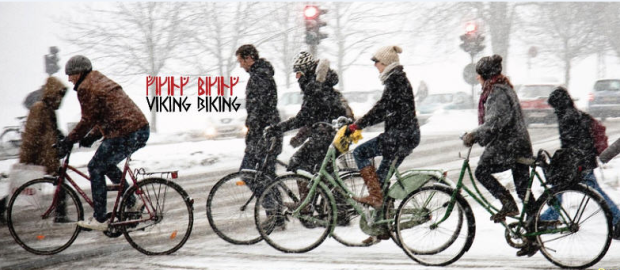
The third world, which is where our main interest in World Streets lies, is day-to-day transport cycling in cities, getting around from A to B, when you want safely and efficiently. This is by far the hardest of all from a public policy perspective, and while it is of course good in a society in which the other two forms of cycling are gaining ground and public support, it is a very large, quite separate challenge in itself. We are really dealing here with the Politics of Transport in Cities.
The World of Safe Cycling on World Streets
Surprising though it may seem to some, the bicycle is playing a turnkey role in 21st century cities, large or small, North or South, rich or poor. Getting city cycling right is a matter of high priority when it comes both to local and planetary environmental impacts, solid economics, affordability, fossil fuel and resource savings, public health, equity, democracy and quality of life. For all of those of our cities around the world who have over the last decades bought into the car plus speed plus distance lifestyle without giving it much thought, getting this transition right is a significant technical, social and political challenge.
Fortunately, there is a large and fast expanding base of experience and information, which should guarantee success for all those who are not too lazy or too much in a hurry to do their homework properly and lay a successful base for their project. In World Streets you can find well more than one hundred articles and sources which can help in the move to more and better cycling in your city. And several dozens more on planning and operating Public Bicycle Systems. So before you spend one penny of precious taxpayer money for that project you are thinking about, read on! It would be a pity not to take advantage of the lessons of experience.
Here in three quick hotlinks is how we try to lend a hand:
- World Streets on Cycling: More than one hundred articles published over the last seen years from a wide range of international sources on cycling issues, with particular attention to planning, policy and experience sharing. You can check this out at https://worldstreets.wordpress.com/tag/cycling/ . (Some 4,351 followers as of this date from 149 countries on all continents.)
- The World City Cycling Forum on Facebook— https://www.facebook.com/groups/worldcitybike/ — where today some 366 members from more than fifty countries occasionally check in, swap information, ideas, working materials and mutual support. To see the faces of these people who care about cycling, click here https://www.facebook.com/groups/worldcitybike/members/ and if you want to have a look at the several hundred photographs and graphics assemble by the group over the last five years, try going here – – https://www.facebook.com/groups/worldcitybike/photos/
- Knoogle: World Streets Knowledge Browser – If you wish to have a first cut of information on any aspect of cycling, try the World Streets Knowledge Browser. You call it up here – https://goo.gl/6YPz20. And then once there, pop in your keywords and see what the carefully selected universe of international sources (more than 700 in all) have to suggest on your topic. To warm up, try some country (why not, try Uganda or Iceland or . . .) and then another key word for narrowing the field further (why not, cycling or whatever you chose to see what it may give), and then inspect your results. Anything useful there? Another trial run might use “helmets and cycling” to checkout the array of sources and articles on one of the more hotly contested cycling topics). You’ll see how it works.
A Latest Offering from the City of Helsinki
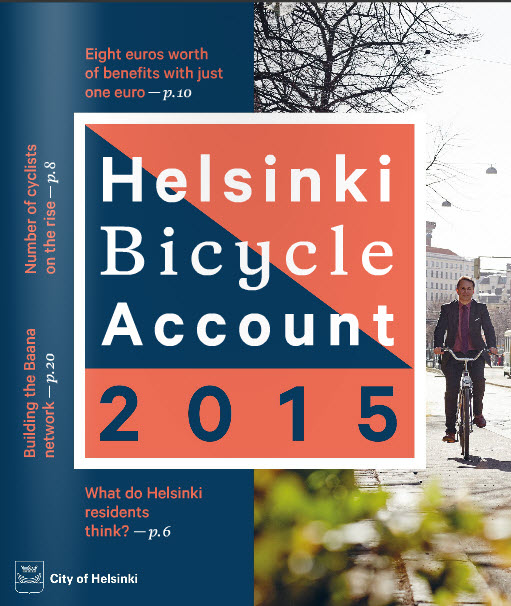
You know (or at least you think you know) quite a bit about cycling in cities like Amsterdam, Portland, Copenhagen or Paris, but what do you know about cycling policy and practice in the city of Helsinki. Well there is now a good reason for you to see how they are dealing with the challenges of safe and abundant city cycling in a Nordic city, a city which almost lost cycling as an option because of the same years of neglect that nearly all of our world cities have endured.
And they have done this as a gift. Originally prepared only in Finnish – all they needed for their own working purposes – they have made a decision to share it with you, me and others who care about their cities, and to do this have created a special edition in English. Here you have to Contents of their just-published report, and for the full report please click to. http://issuu.com/helsinkisuunnittelee/docs/pyorailykatsaus_2015_en_issuu.
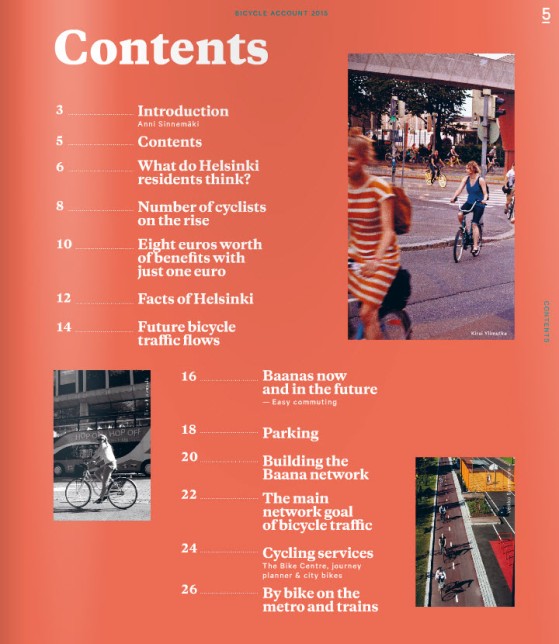
And finally, how do you know if your city is succeeding?
There are three simple acid tests:
- Females: Are fully half of those cycling to work, school or wherever they need to go this morning in your city female? If so, you have succeeded (though there is always more work to to). If not, you really are in trouble. Really! You have to so something about it.
- Helmets: Are the great majority of the people cycling on the street without helmets? If so, they think it’s safe. If not, they think it’s not. And the clear signal of good cycling in cities is that people feel safe. (Again if you need to refresh your arguments on this, check out the several above indicated sources.)
- Children: Are you children able to cycle to school every day, without your worrying about them.
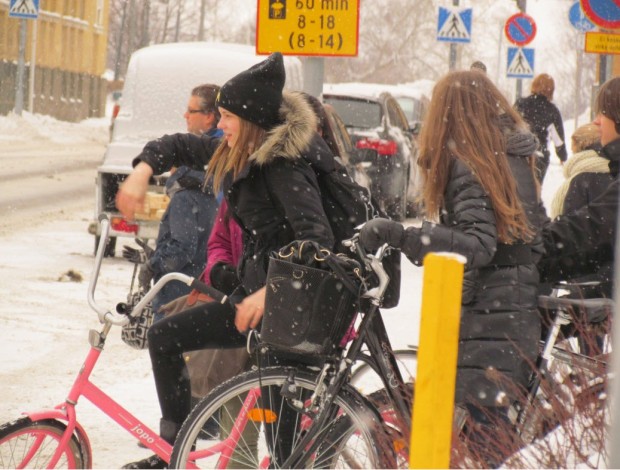
That’s it. The acid test. Now (a) how are you doing? And (b) you really know what to do. But will you have the vision, the courage to reach those objectives of a civilized and just city?
And if you need more inspiration and help turn to the Helsinki report – http://issuu.com/helsinkisuunnittelee/docs/pyorailykatsaus_2015_en_issuu — scroll over to the Table of Contents, and look just below the page itself. And you will see a very large number of outstanding reports done by different groups in different parts of the world, all of which are helping us move toward a World Cycling Agenda.
Thanks Helsinki. Team work!
# # #
About the editor:
Eric Britton
13, rue Pasteur. Courbevoie 92400 France
Bio: Founding editor of World Streets (1988), Eric Britton is an American political scientist, teacher, occasional consultant, and sustainability activist who has observed, learned, taught and worked on missions and advisory assignments on all continents. In the autumn of 2019, he committed his remaining life work to the challenges of aggressively countering climate change and specifically greenhouse gas emissions emanating from the mobility sector. He is not worried about running out of work. Further background and updates: @ericbritton | http://bit.ly/2Ti8LsX | #fekbritton | https://twitter.com/ericbritton | and | https://www.linkedin.com/in/ericbritton/ Contact: climate@newmobility.org) | +336 508 80787 (Also WhatApp) | Skype: newmobility.)

You forgot working cyclists – we are definitely in a whole other world…
I did not exactly forget them Zero, it was just that I was not quite sure how to fit them in. Now I would like to amend that. Possibly with your help?
I remember reading this article a dozen years ago from TA in New York, which I thought to be a good idea. But I as a guy who uses bikes to get from A to B and who have lived in places and have seen a lot of working cyclists in action (and at rest) have always thought of them as something closer to an exotic (and all too often endangered) species, and as such defy normal systems of categories.
If you want to push me a bit on this, point me to some references , I can try to make good on this.
Thanks for drawing this to my attention.
————
T.A. Launches “Working Cyclists” Program
Safety education for food delivery cyclists and couriers
T.A. is teaching working cyclists and their employers about bicycle safety, including respecting pedestrians by staying off sidewalks.
The image of cyclists as sidewalk riding maniacs who bully and threaten pedestrians poisons political support for cycling. Unfortunately, it has become a New York City stereotype, just like demented cab drivers. In neighborhoods like the Upper East and West Sides, persistent problems with pedestrian-unfriendly cyclists, many of them in a rush to deliver food, has created considerable enmity towards all cyclists. It has also contributed to the city council’s endless attempt to ratchet up the penalties for cycling offenses, and distracted lawmakers and the public from the far more dangerous problem of reckless motor vehicle drivers. In 2002, the city council once again raised the penalty for cycling on the sidewalk, though it did not increase any penalties for driving or parking on sidewalks, or hitting pedestrians in crosswalks. People’s aggravation with sidewalk cycling also fuels opposition to cycling projects and makes city agencies and elected officials more wary of supporting cycling improvements.
In an effort to improve bicyclist and pedestrian safety and improve the image of bicyclists, T.A. has launched the “Working Cyclists: Safety education for couriers and food delivery cyclists” campaign. The goal is to get bicycles off sidewalks and reduce the number of bicycle-pedestrian crashes, injuries and near misses. As part of this campaign, we are working on getting businesses to take responsibility for the actions of their working cyclists.
The Working Cyclists campaign fills an education void. Most working cyclists, many of whom are new immigrants, receive zero safety training from their employers. Few employers are familiar with the New York City laws that pertain to working cyclists.
T.A. is working with city council members, the NYPD and community boards to develop materials and target businesses to increase safety. This summer, T.A. developed trilingual, English-Spanish and English-Chinese safety classes, manuals and posters that teach working cyclists and their employers the laws of bike riding in New York City. Over the fall, T.A. will teach safety classes to businesses identified by elected officials, the NYPD, community boards and the public.
The project will initially focus on Midtown Manhattan and the Upper East and West Sides, where sidewalks are jammed with pedestrians and the dangerous behavior of many working cyclists is a chronic problem.
Articles? There are a number of books, movies, websites and what have you on the subject. I used to contribute the odd article myself many moons ago…
But really, the point is that we have always been seen as ‘other’ even by the other cycling tribes (even though many of us are a part of those tribes as well) – and we somewhat embrace that… We enjoy (to a certain extent) the romantic notion of a piratical lifestyle on the fringes of society and actively encourage the stereotype. I have often pointed out to my brothers and sisters, that if cycling becomes normalised we will lose our status as the Lost Boys (cf Peter Pan) of cycling and will become part of the homogeneous mass of the city. Part of me looks forward to that day, part of me dreads its inevitability…
Pingback: Another rough day on the road, and the Feed | Witch on a Bicycle
Thanks for the great article. I couldn’t agree more. Whereas most people group all cyclists together, there are distinct types of bicycle riders that have very little in common with each other. While I like your categories and fully agree with your commentary (as well as Zero’s fourth category), I have my own three categories of bicyclists that are equally disparate:
– road riders
– mountain bikers
– trail riders
Most people are familiar with the first two categories, but completely ignore the third or group it in with one of the first two. Examples of trail rider venues include: rail trails, urban trails, canal trails, river trails, etc. Road riders are usually all about speed or function (commuting), mountain bikers are often into adventure/adrenaline, and trail riders are into leisure, function or active travel. I’ve noticed distinct personality types in each of the three different types of bike riders described above.
Thanks for sharing your views. It’s nice to see that, although our categories are different, we agree that all bicyclists aren’t the same.
Pingback: The Three Worlds of Cycling | J.Ann Jones